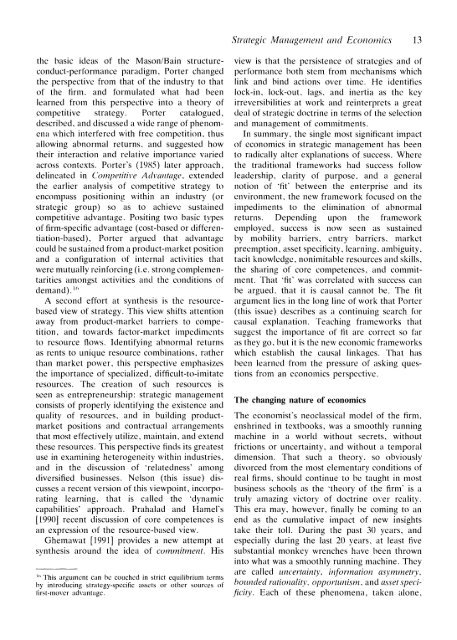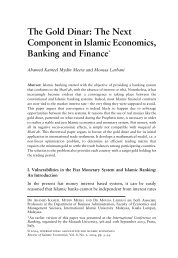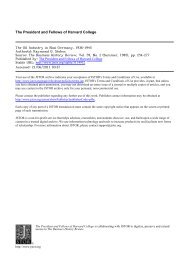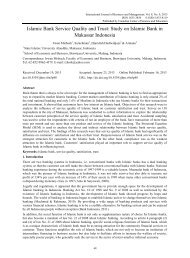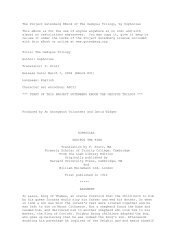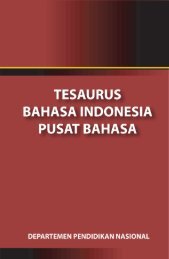Strategic Management and Economics
Strategic Management and Economics
Strategic Management and Economics
Create successful ePaper yourself
Turn your PDF publications into a flip-book with our unique Google optimized e-Paper software.
Strat gic ainaiagement (anld <strong>Economics</strong> 13<br />
the basic ideas of the Mason/Blain structure- view is that the persistenice of strategies <strong>and</strong> of<br />
conduct-performiance paradigm, Porter changed performance both stem from mechanisms which<br />
the perspectivc from that of the industry to that link <strong>and</strong> binid actions over time. l-ie idenitifies<br />
of the firmi. <strong>and</strong> formulated what had been lock-ini, lock-out, lags, <strong>and</strong> inertia as the key<br />
learned froimi this perspective inlto a theoiry of irreversibilities at work <strong>and</strong> reinterprets a great<br />
competitive strategy. Porter catalogued, deal of strategic doctrinie in terms of the selection<br />
descr-ibed, <strong>and</strong> discussed a wNide range of pheniom- <strong>and</strong> managyemnent of commiiitimietits.<br />
ena w-hich initerfered with frec conipetitioni, thus In suimmiry, the single most significant impact<br />
allowing abnormal returns, <strong>and</strong> suggested hiow of econlomilics in strategic management has been<br />
their interaction <strong>and</strong> irelative importance varied to radically alter explanations of success. Where<br />
across contexts. Porter's (1985) later approach, the traditional frameworks haid success tollow<br />
delineated in C'omIetitive AdMvatage extenidedt leadership. clarity of purpose, anid a general<br />
the earlier analysis of competitive strategy to niotioIl of 'fit' betweeni the enterprise <strong>and</strong> its<br />
encompass positioniilg withini an inidustry (or enivironimlenlt, the niew framework focusecd onl the<br />
strategic g roup) so as to achieve sustained impedimiienits to the elimination o.f abnormli<br />
comilpetitive advantage. Positinig two basic types r-eturnis. Dependiinig upoIn the frarmework<br />
of firn-specific advantage (cost-based or differenl- emilployed, success is nlow seen as sustained<br />
tiation-based), Porter argued that advantage by mobility barriers, entry barriers, market<br />
could be sustained fi-om ia prioduct-miairket positioIn<br />
<strong>and</strong> a configuration of internal activities that<br />
preemiiptioni, asset specificity, leariniiig, ambiguity.<br />
tacit knowledge, nonimitable resources ailnd skills.<br />
were mutullly reiniforcinig (i.e. stronig comlplemileni- the shar-inig of core colimpetenices, <strong>and</strong> coimmittarities<br />
anmongst activities <strong>and</strong> the conditionis of menit. That 'fit' was correlated with success can<br />
demr<strong>and</strong>).'"<br />
be argued. that it is cauSaIl cannot be. The fit<br />
A second effort at synthesis is the resource- argument lies in the long linie of work that Plorter<br />
based view of strategy. This view shifts attention (this issue) describes as a continluinig search for<br />
away from product-mnarket barriers to coIlmpe- causal explaniation. TFeaching frameworks that<br />
tition, <strong>and</strong> towiards factor-market impedimiienits suggest the importanince of fit are correct so far<br />
to resotuce flows. Identifinga abnormal returnis as they go, but it is the new economilic frameworks<br />
as rents to uniqlue resource combinations, rather which estalblish the causal linkages. That has<br />
than market pover, this perspective emphasizes been learined from the pressure of askinag questhe<br />
importaince of specialized, difficult-to-imitate tioIns from an econ omiiics perspective.<br />
resources. The creationi of such resources is<br />
seeni as entreprenleurship: strategic management<br />
conisists of properly idenitityinig the existence <strong>and</strong><br />
TFhe changing nattire of economics<br />
quality of resources, <strong>and</strong> in building product- The econoimist's neoclassical moodel of the firm.<br />
market positioins <strong>and</strong> contractual arrangements enshrinied in textbooks, was a smoothly runninilg<br />
that monst effectively utilize, maintain, aind extend machinie in a world without secrets, without<br />
these resources. This perspective finids its greatest frictions or uncertainty, <strong>and</strong> without a temporal<br />
use in examining heterogeneity withini industries, dimenisioni. That such a theory. so obviously<br />
<strong>and</strong> in the dliscussioni of 'relatedness' aIIlmoig divorced from the mlost elementarv conditionis of<br />
diversified businesses. Nelsoni (this issue) dis- real firms, should continue to be taught in most<br />
cusses a recenit versioni of this viewpoint, incorpo- businiess schools as the theory of the firm' is a<br />
Irating(, learnincg, that is called the 'dyarnmic truly! amiazing victorv of doctrine over reality.<br />
capabilities' approach. Prahalad <strong>and</strong> Hamel's Thiis erai miy. however, finallv be comliling to an<br />
[1990] recent discussion of core competenices is end(i as the cumulltive impact of new insights<br />
an expressioni of the resource-based view. take their toll. During the past 3() years, <strong>and</strong><br />
Ghemawat [1 991] provides a new attempt at especially during the last 2() years. at least five<br />
svnthlesis around the idea of comnnitment. His substantial monkev wrenches have been throwin<br />
into what was a smoothly runiniiig maichinie. They<br />
T5 l his airgument can be couched in strict equilibrium terms<br />
by introducillg straitegy-specific assets or other sources of<br />
first-mover advantage.<br />
are cal led uncertain tx', itnforination asymmnietry,<br />
bouniided rationazlity. opportunisni, <strong>and</strong> asset specificity.<br />
Each ot these phenoimenaii, takeni alone,


